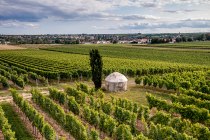Winery Wittmann
The Wittmann winery is one of the leading estates in the Rheinhessen region. In addition to Riesling as the main grape variety, the Pinots and Silvaner are of particular importance in the winery. Through biodynamic cultivation, intensive vineyard maintenance and traditional wine making wines are made with their own character, great terroir and high quality. The VDP.Grosse Lage are MORSTEIN, BRUNNENHÄUSCHEN, KIRCHSPIEL and AULERDE. The winery is a member of the VDP - The Prädikatsweingüter.











